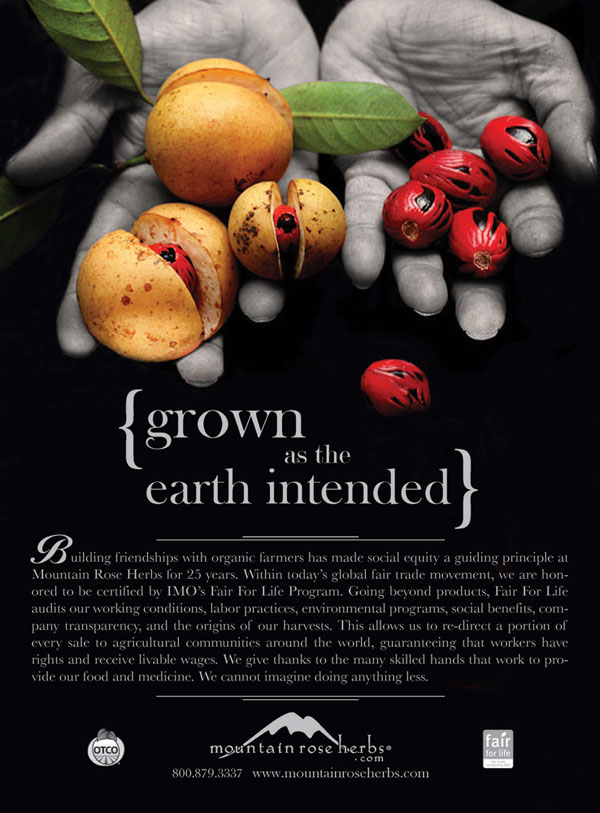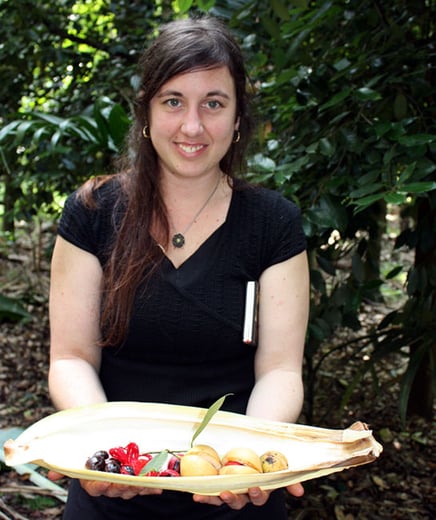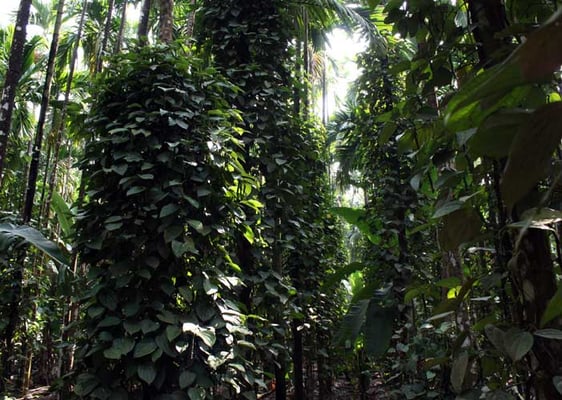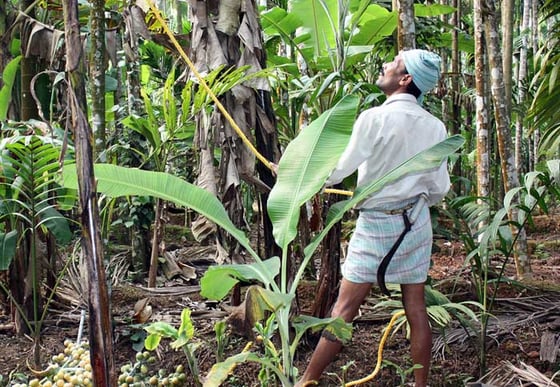Jennifer Gerrity is the Operations Manager here at Mountain Rose Herbs. With a diverse background of interest and experience in the botanical world, she is the perfect person to oversee our staff and day-to-day production. Jennifer also travels the world, procuring herbs and connecting with organic farmers to ensure that quality and working conditions meet our strict standards. Last year, Jennifer traveled to India and returned with a real jewel of a photo. Her gorgeous shot of nutmeg was used in our latest ad highlighting our fair trade practices. Have you seen it? We've received an incredible response to the ad with people wondering where the photo was taken. Here's the story behind her trip to India and the hands behind the photo...
Kibbachlu is a small tropical area in Karnataka, home to the farming projects that produce many of our beloved Indian spices. Composed of amazing agro-forest plots, this vast jungle farm grows betel nut, bird’s eye chili, bananas, black pepper, nutmeg, clove, cardamom, vanilla, and coffee. All of these cultivated crops are growing and thriving together in a dense organic forest. This is certified organic, hand cultivated land, but as we walk through the thick green, it feels wild.
The pillars of the farm are the betel nut trees. These tall palms cast shade on the understory and provide support for climbing vines. Mid-story trees include coffee and banana dotted all around the plots. The gorgeous understory is made up of clove, allspice, and nutmeg trees. A lower layer of shrubs and smaller plants like bird’s eye chili and cardamom require the cool shade. Climbing vines of black pepper and vanilla bean grow up the trunks of the betel nut trees. The pepper vines are so massive that they nearly reach the top of the canopy! The forest floor is littered with large palm leaves from the betel nut, and caretakers of the land purposely leave a thick layer of detritus for a rich natural hummus. Mosses, ferns, and tropical plants of all kinds thrive in this layer.
Hand dug trenches used for rainwater retention and irrigation can be found throughout the agro-forest. Many of the vine crops are propagated in small nurseries nearby and will have to be replaced each year after the monsoons roll through.
The betel nut harvest is underway. This crop is mostly sold on the local domestic market in India for a stimulating chew called paan. A large operation is set up where the husks of the nuts are hand shucked, then boiled to release the dark red pigment. This fluid is sold as dye for the textile industry. The nuts are then dried in the sun, often on rooftops or cement patios, roasted, then stored in bags until ready for sale. All around the forest, you can hear the sound of workers shimmying up the tall betel nut trees and dropping large inflorescences down to harvest the ripe nuts from the ground.
Nutmeg is also being harvested, although this crop is mostly handpicked from the ground level since the trees are much smaller than betel. The nutmeg is encased in a pithy outer fruit. When ripe, this fruit naturally splits and is hand shucked to reveal the shiny dark mahogany colored nutmeg inside. The nutmeg is covered with a bright red aril, also known as mace. When the nutmeg is dried the mace aril naturally lifts away and is hand plucked from the nutmeg seed. Nutmeg (Myristics fragrens) is the only tropical tree responsible for two spices, both of which have historically had a larger world demand than tropical production can supply.
Nutmeg is dioecious, so the fruits only appear on the female tree. The season is limited and the fruits are sparse, making this a highly coveted and prized combination of spices with a deep and culturally rich history. The trees take 7-9 years to mature and 20 years to reach full production. The harvest and separation process is labor intensive, as the crop is delicate and requires great care and knowledge.
Prakash is a friend and master organic farmer in the state of Karnataka. He has pioneered innovative intercropping methods which have become a living classroom for farmers from other states and regions. He is famous in this area for maximizing yield per hector of a variety of crops due to his knowledge of tropical spice and medicinal plant production, requirements, and care.
While walking through the forest, Prakash showed off this season’s bounty, displaying all parts of the nutmeg fruit. It was so striking that I had to stop and photograph the treasure in his hands. This photograph captured a moment of pride, wisdom, and success in the vulnerable field of spice production, as well as a deep and powerful connection between Mountain Rose Herbs and our farms. A moment in time captured the spirit of our symbiotic partnership, relishing the literal fruits of our joined knowledge and efforts.














